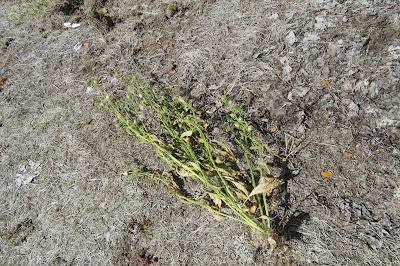 |
| Native plants in the Sunflower family naturalize well in gardens. |
The
term naturalizing refers to using flowering plants in a way that mimics
Mother Nature. People often speak of ‘naturalizing
bulbs’. But plants that produce viable
seeds can also be used to naturalize.
The trick is to spread the seed about the garden in a way that looks
natural. And the best way to do that is
to observe how plants group themselves in nature.
 |
| In the wild, Sunflowers often cluster in areas with optimal growing conditions. |
In
the Western U.S., plants in the Sunflower family (Asteraceae) are easy
to observe in nature. In a natural
setting, plants often occur in clusters spread across the landscape. There are often areas between these clusters:
places where conditions are poorly suited for the establishment of plants by
seeds or runners (rhizomes).
 |
| Native Lupines and Phlox form a lovely natural pattern. |
The
establishment pattern can also indicate wind patterns, since many small seeds
are distributed by wind. This is true of
seeds specially adapted to wind distribution (those with feathery ‘parachutes’),
as well as seeds that are simply blown along the ground. And several species of plant are often
interspersed, forming interesting patterns (above).
When
naturalizing native flowering plants in the garden, you can’t go wrong by following
the patterns of nature. This can be achieved
in at least three ways: 1) by letting plants re-seed themselves; 2) by harvesting
annual plants (or portions of perennials) and laying them in a desired setting;
3) by collecting seeds and planting them in natural-looking clusters.
 |
| When native plants self-seed, the seedlings often cluster near the parent plant. |
Letting plants re-seed themselves
This
is the easiest method of all. It also
produces a natural-appearing distribution of plants, since the same forces that
distribute seeds in the wild are at work in the garden (above). Self-reseeding works for both annuals and
perennials – even plants grown in containers and set out in the garden to
re-seed. The disadvantage of this method
is that the process requires time. To
establish plants in several areas of the garden more quickly, you’ll need to
give Mother Nature a helping hand.
 |
| We call this the 'lazy naturalizer' method. It is a good method for naturalizing some plants. |
Re-seeding
using whole (or portions) of plants
We call this
the lazy naturalizer method. It works
for annuals, perennials that need to be culled, or perennials that you cut back
after seed is ripe. This method does a good job of producing natural looking plant
clusters, in desired areas of the garden.
And it’s often the easiest way to deal with tiny seeds.
Simply
wait until seeds are ripe on the plants (pods open, seeds are dry, or birds are
starting to eat them). Harvest entire
plants (or cuttings with seed pods/heads) and simply place them on bare ground
in the desired spot. The dying plants will look a little untidy during fall
(above). But they provide a protective
mulch over winter and will often break down by the following spring. They also
protect seeds from seed-scavenging birds (somewhat).
You can stomp
on the dried plants - or cut them up into smaller pieces to make them less
conspicuous - for fall and winter. In spring, new seedlings will emerge,
protected by the natural mulch. There
may be too many seedlings. You can thin
them (or, if you are lazy, just let nature take its course).
 |
| Seeds are best dried and stored in paper bags in a cool, dry place. |
Collecting and spreading seed
You
can also collect the seed and store it until it’s time to plant (more on that
next month). Let seeds dry on the
plants. Harvest the dry seeds and store
in paper bags (or glass jars) in a cool, dry place until planting. If seeds grow
in papery pods or in a typical sunflower ‘head’, you can harvest entire pods/heads,
place them in a paper bag in a cool, dry place (above) and let them fully dry. Seeds can then be more easily separated and stored.
When
planting, remember the lessons of nature. Plant clusters of seeds across the
landscape to give a natural appearance. Intersperse seeds of different species
to add interest and look more authentic. And be sure to plant seeds on bare ground or
in areas with only a thin inorganic (gravel) mulch.
 |
| Success!! A new plant from seed. |
We hope you’re inspired to try these suggestions for naturalizing plants by seed. These methods work well for any plants that produce plenty of viable seeds (note: some cultivars to not). The sunflowers come to mind: sunflowers, goldenrods, cone flowers, asters, rabbit bushes, etc. all naturalize easily. But wild tobaccos, milkweeds, valerians, four-o’clocks, ranunculus, buckwheats, campanulas and many native grasses, bulbs and wildflowers also naturalize well.
_____________________________________________
We welcome your comments (below). You can also send your questions to: monaturesmontrosegarden@gmail.com


No comments:
Post a Comment